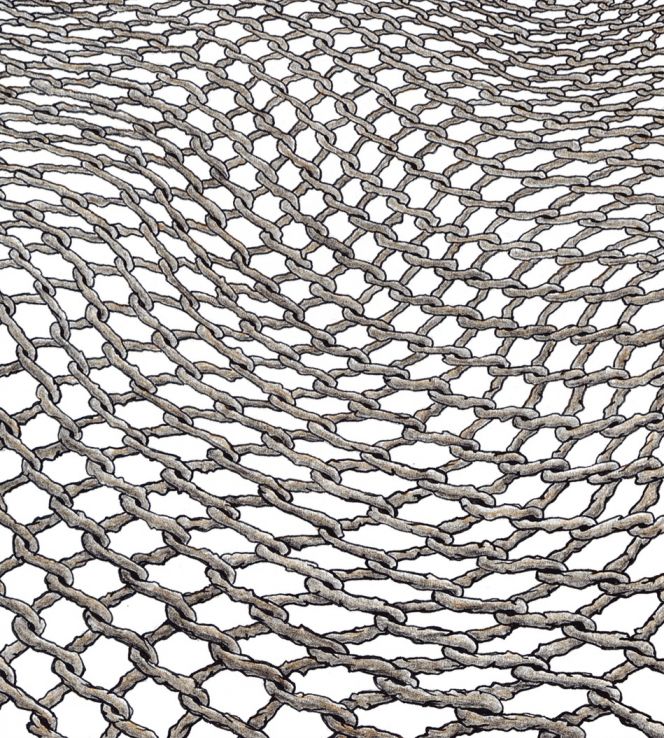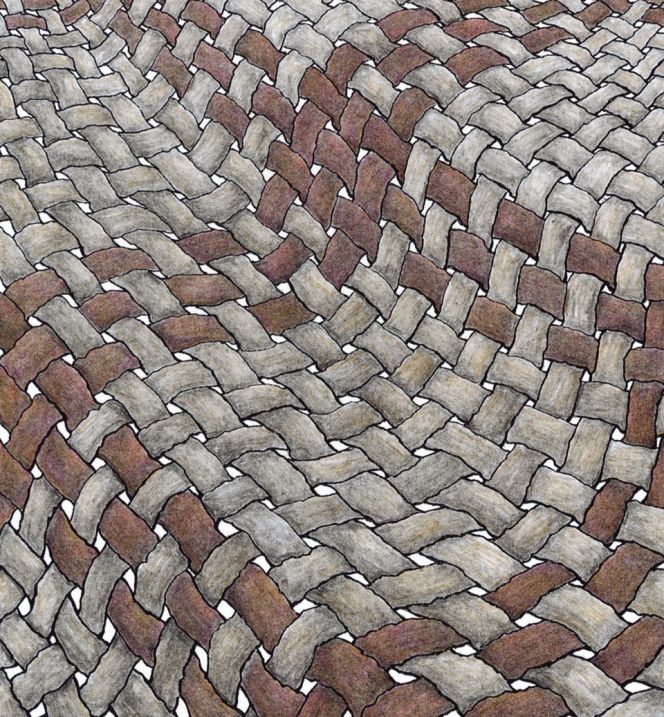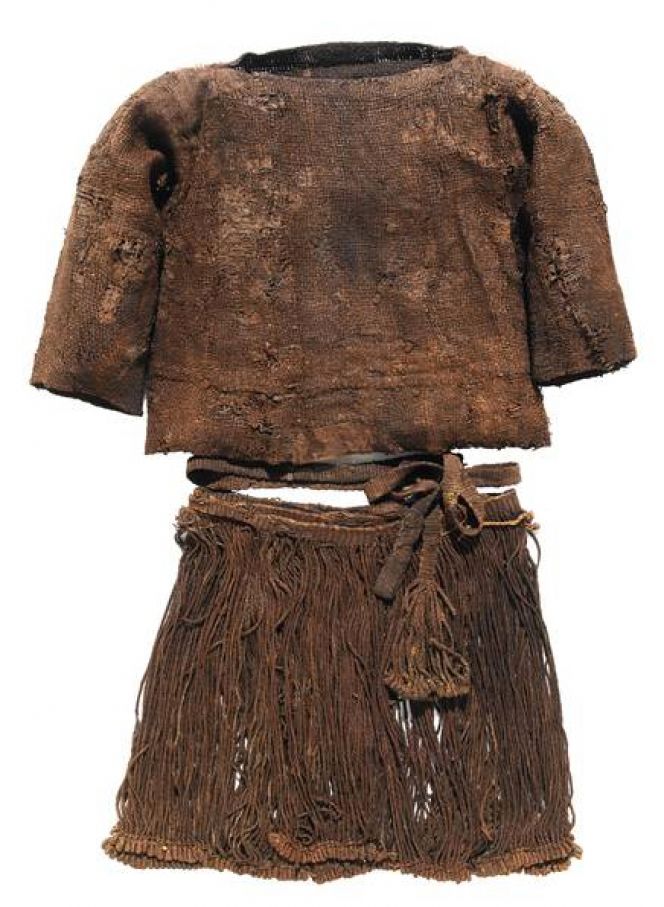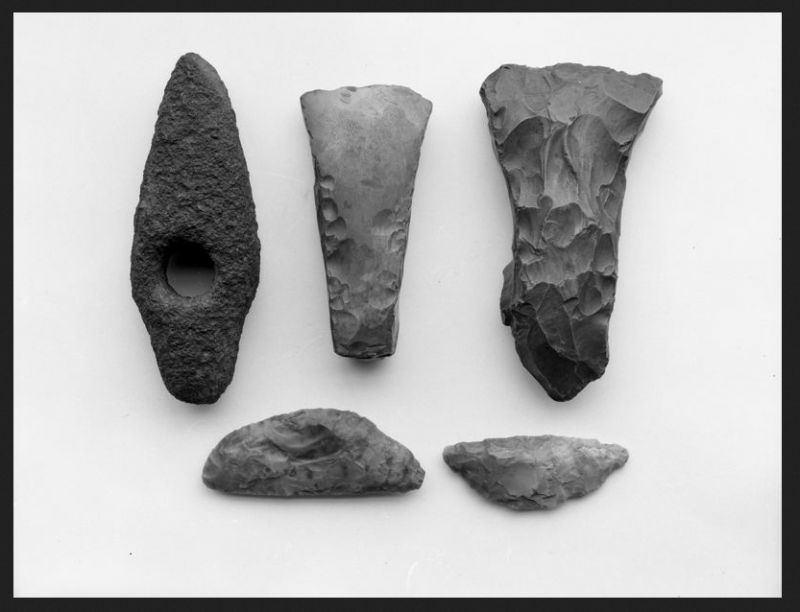ikfoundation.org
The IK Foundation
Promoting Natural & Cultural History
Since 1988


NORDIC BRONZE AGE TRADITIONS
– a Textile Study
A number of years ago, I published three articles in the yearbook Elbogen about textile trades and material culture of the Malmö area in southernmost Sweden – stretching from the earliest settlements up to the 20th century. The aim of this new series of essays is to translate parts of these texts into English and put their local historical events into a broader European perspective with additional discussions and images. This first part introduces the Stone Age period and continues into the Nordic Bronze Age (1800 to 500BC) – a time when skin garments went through refinement simultaneously with the early development of woven woollen fabrics and plaiting techniques.
 An impression of a tiny textile fragment’s technique found just south of present day Malmö (Petersborg), during an excavation. The minuscule piece is believed to have been either plaited or made using a knotless netting technique called “sprang”. The find has its origin in the younger Stone Age period and was examined by the Danish textile historian Lise Bender Jørgensen. She emphasised that the nature of the raw material has not been possible to verify, as the carbonised find weighs one gram only. But after C14 analysis it could be established that it once originated from 3970-3630BC and is therefore one of the oldest textile remnants from northern Europe. Illustration: Helen Hodgson (2001).
An impression of a tiny textile fragment’s technique found just south of present day Malmö (Petersborg), during an excavation. The minuscule piece is believed to have been either plaited or made using a knotless netting technique called “sprang”. The find has its origin in the younger Stone Age period and was examined by the Danish textile historian Lise Bender Jørgensen. She emphasised that the nature of the raw material has not been possible to verify, as the carbonised find weighs one gram only. But after C14 analysis it could be established that it once originated from 3970-3630BC and is therefore one of the oldest textile remnants from northern Europe. Illustration: Helen Hodgson (2001).The earliest settlement from the Malmö area is approximately 11000 years old, known from archeologically excavated flint implements used by the hunters in their daily life. For the development during the continuing period of the Stone Age (9000-4000BC), it can be concluded that an increasing number of skins from reindeer, brown bear, moose, boar, red deer and other mammals were used for various needs. These skins – not preserved today – were worked with scraping implements and bone awls. From the proceeding historical period (4000-1800BC), even larger quantities of these kinds of tools have been found, which implies a growing population. The garments produced were further refined with the help of finer awls, which were used for making holes where tendons could form a seam with a bone needle. The various skin and fur clothes now have the possibility to get an improved fit and become more comfortable as well as warmer for the wearer. At the end of this period, archaeological excavations revealed that the population came to be more settled and started keeping domestic animals. The sheep, in particular, are believed to have been of importance for the textile development – even if wool had not been found – but on the other hand, spindle whorls used for spinning fibres are among the findings. If weaving techniques were known in the area at this time is uncertain, so the twisted fibres (probably wool) could most likely have been used for various plaits.
 Woven fabric was introduced on a larger scale during the Nordic Bronze Age (1800-500BC). The simple plain weave was the technique closest resembling plaiting and therefore probably the earliest style of weaving. Nevertheless fabrics of all sorts have limited chances of survival for thousands of years, various degrees of decay depending on the surrounding circumstances must also be taken into account. Illustration: Helen Hodgson (2001).
Woven fabric was introduced on a larger scale during the Nordic Bronze Age (1800-500BC). The simple plain weave was the technique closest resembling plaiting and therefore probably the earliest style of weaving. Nevertheless fabrics of all sorts have limited chances of survival for thousands of years, various degrees of decay depending on the surrounding circumstances must also be taken into account. Illustration: Helen Hodgson (2001).From a textile point of view, brooches and pins in bronze or silver are an essential category of finds from the Malmö area, objects that may have been used for fastening or as decorations for clothing made from both woven fabrics and skins. Bronze awls have also been unearthed – as burial gifts in male as well as female graves – during excavations at Bulltofta. This may indicate that both sexes were involved in the production of clothes, or alternatively that the awls had other areas of use. Another tool used for sewing or embellishing garments was the needle, found in bronze and bone, from settlements in Fosie and Skrävlinge.
The area is believed to have had a lively trade and a net of contacts stretching through middlemen from various places in Europe due to influences of styles on bronze, pottery and stone objects/implements. The knowledge collected from excavations makes us understand that the population increased considerably, not only because of the more significant number of excavated finds but also because the settlers lived in larger houses situated closer to each other than previously. From these communities, woven fabrics also seem to have been more and more common, as proved by found loom-weights of fired clay from Sallerup, Fosie and Svågertorp. These loom-weights were once part of the so-called “opstagogn” or upright loom, initially where plain woven fabrics were produced (see images 2 & 3). Additionally, spindle whorls of clay and bronze dating from the Bronze Age have been found in other parts of Skåne in southernmost Sweden. The Danish bog finds complete garments in brownish wool – the best-preserved burial finds dating from this period are described below – and also gives us clues that neither wool, yarn, nor ready-made cloths were dyed at this time in the Nordic area.
 A study of the very well-preserved Danish bog find “The Egtved Girl” (c. 1370BC), can give us many ideas of both weaving and plaiting techniques during the Nordic Bronze Age. Her clothing included a cord skirt tied with a woven tasselled ribbon at the waist and a plain woven short blouse – all in wool. As described by the National Museum in Denmark; the oak coffin find also consisted of ‘a pair of foot warmers, a cord, a blanket and various small pieces of woollen textile’. The Malmö area on the other hand, with its clayey soils, makes it difficult for textiles to be preserved for a longer period of time. However, animal fibres and particularly wool have a somewhat increased possibility compared to vegetable fibres as flax or hemp to be preserved. Additionally, textile fibres of all kinds may have a better chance if once being placed close to a bronze or silver object, whose chemical deposits can have preserving effects on textiles. Courtesy of: Nationalmuseet in København, Denmark.
A study of the very well-preserved Danish bog find “The Egtved Girl” (c. 1370BC), can give us many ideas of both weaving and plaiting techniques during the Nordic Bronze Age. Her clothing included a cord skirt tied with a woven tasselled ribbon at the waist and a plain woven short blouse – all in wool. As described by the National Museum in Denmark; the oak coffin find also consisted of ‘a pair of foot warmers, a cord, a blanket and various small pieces of woollen textile’. The Malmö area on the other hand, with its clayey soils, makes it difficult for textiles to be preserved for a longer period of time. However, animal fibres and particularly wool have a somewhat increased possibility compared to vegetable fibres as flax or hemp to be preserved. Additionally, textile fibres of all kinds may have a better chance if once being placed close to a bronze or silver object, whose chemical deposits can have preserving effects on textiles. Courtesy of: Nationalmuseet in København, Denmark.The only textile/leather items from the Malmö area, which can be dated to the Bronze Age period, were excavated from a grave field at Kristineberg. The archaeologist Lena Hejll described the fragmented find as consisting of two small pieces of s-twisted single yarn, whereof one of the pieces is attached to a small piece of leather or felted wool. The fact that the yarn was spun pointed in a direction to that spindle whorls were used for spinning yarn in the area. At the same time, felted wool probably may have been a technique used for making garments denser and warmer, while the piece of leather, in combination with the many excavated skin scrapers, is proof that leather/skin/fur still were important materials for the population’s clothing.
 The two small-sized implements were possibly used for preparing skins for clothing. Bronze Age finds (axes and hide scrapers) originating from Hindbygården. Courtesy of Malmö Museer: Photo by unknown photographer (EH 000681).
The two small-sized implements were possibly used for preparing skins for clothing. Bronze Age finds (axes and hide scrapers) originating from Hindbygården. Courtesy of Malmö Museer: Photo by unknown photographer (EH 000681).If the flax fibre was in use for textiles during the Nordic Bronze Age, is on the other hand uncertain, even if a smaller number of flax seeds have been found during excavations in Lockarp. C14 analysis has indicated that the seeds originate from 800-500BC, making it one of the earliest observations of this kind in Sweden. Additionally, a similar close-by find of flax seeds was also detected at Svågerup, dating from 800-200BC. However, the archaeologists cannot secure any evidence for textile flax production, and the seeds are instead believed to originate from flax as an oil plant used for cooking. Another important factor is that the first Nordic finds of textile linen fragments have been dated to 200AD – or circa 700 years later in the Nordic Iron Age – which probably establishes a more realistic timescale for the introduction of this useful textile material.
Notice: Place names in italics are geographical areas, today within or very closely situated to the city of Malmö. For a full Bibliography and a complete list of excavated fragments, tools, etc, please see the Swedish article by Viveka Hansen, 2001.
Sources:
- Hansen, Viveka, ‘Förhistoriska och Medeltida Textilier i Malmö’, Elbogen pp. 73-144. 2001 (pp. 73-88).
- Malmö Museer, Sweden (Digital source: Image, The Bronze Age, implements).
- Nationalmuseet, København, Denmark (Digital source, Egtved girl’s dress).
Essays
The iTEXTILIS is a division of The IK Workshop Society – a global and unique forum for all those interested in Natural & Cultural History from a textile Perspective.
Open Access essays, licensed under Creative Commons and freely accessible, by Textile historian Viveka Hansen, aim to integrate her current research, printed monographs, and earlier projects dating back to the late 1980s. Some essays feature rare archive material originally published in other languages, now available in English for the first time, revealing aspects of history that were previously little known outside northern European countries. Her work also explores various topics, including the textile trade, material culture, cloth manufacturing, fashion, natural dyeing, and the intriguing world of early travelling naturalists – such as the "Linnaean network" – viewed through a global historical lens.
For regular updates and to fully utilise iTEXTILIS' features, we recommend subscribing to our newsletter, iMESSENGER.
been copied to your clipboard




– a truly European organisation since 1988
Legal issues | Forget me | and much more...
You are welcome to use the information and knowledge from
The IK Workshop Society, as long as you follow a few simple rules.
LEARN MORE & I AGREE







